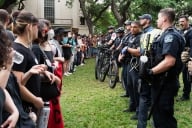You have /5 articles left.
Sign up for a free account or log in.
Carol Folt, chancellor of the University of North Carolina at Chapel Hill, apologized for the university’s role in slavery during her speech on the university’s 225th birthday.
“As chancellor of the University of North Carolina at Chapel Hill, I offer our university’s deepest apology for the profound injustices of slavery, our full acknowledgment of the strength of enslaved peoples in the face of their suffering, and our respect and indebtedness to them,” she said. “I reaffirm our university’s commitment to facing squarely and working to right the wrongs of history so they are never again inflicted.”
Folt issued her apology amid an ongoing controversy surrounding Silent Sam, a Confederate statue in the middle of campus that was pulled down by student activists earlier this fall. University officials had been mild-mannered about Silent Sam, caught between students calling for its removal and board members and political figures asking for Sam to remain standing. The university is currently searching for a new location for the statue. Faculty leaders are calling for it to never return to campus.
James Leloudis, a history professor at UNC-Chapel Hill and co-chair of the chancellor’s task force on UNC-Chapel Hill history, detailed several remedial steps the university will take to confront its role in slavery. These include signs posted on the quad to mark the “birthplace of American public higher education” and acknowledge the indigenous people who “were the first stewards of this land, and whose descendants work, study and teach here today.” There will also be a marker at the Unsung Founders Memorial, which will be repaired and renovated, that will express the university’s remorse for its role in slavery.
Leloudis referred to Silent Sam briefly as the “Confederate monument” and said that once there is a plan for its relocation, the university will conduct research to “inform an exhibit and other educational materials to teach the history of the monument and the era of white supremacy in which it was erected.”








